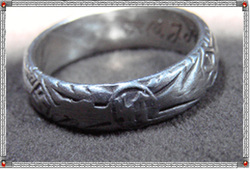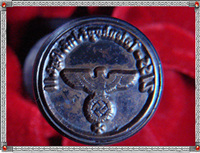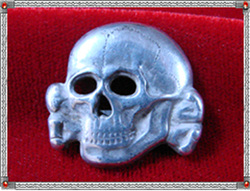
“Clear the streets, the SS marches, The storm-columns stand at the ready. They will take the road, From tyranny to freedom. So we are all ready to give our all, As did our fathers before us. Let death be our battle companion. We are the black hand.” Leibstandarte SS Adolf Hitler Marching Song (Hitler’s Teutonic Knights pg. 10). Ancient and medieval in its “lineage”, pagan and pseudo scientific in its beliefs, and totalitarian in its exercise of power and brute force, the Schutzstaffel, more commonly known by its abbreviated nomenclature, the SS, was, as an organization, the physical and political personification of Nazism in Hitler’s German Third Reich. At its inception in 1925, during the reign of the Weimar Republic, the SS was little more than a poorly organized band of thugs and criminals. Yet within 10 years, Heinrich Himmler’s quasi-Teutonic order would not only assist Hitler in his rise to total dominance over Germany but would establish itself in its own right as the most revered and dreaded political, paramilitary, and later military, organization in all the Reich.

Click for more information.
To understand the German mindset of the pre World War Two populace and their tacit obedience, acceptance, and even approval of the Nazis party and its various organizations, chiefly the SS, one must take into account the history of rampant European anti-Semitism, the lifeblood of the Nazis party. “By decree issued in Berlin March 12, 1933, the Nazi banner together with that of the Old Empire was proclaimed the flag of Germany. Upon it was inscribed the Swastika- symbolizing hatred of the Jew and in that sign the new German Government, with Hitler at its head, declared and is waging official and relentless war upon 600,000 of its own citizens.” (Swastika: The Nazi Terror pg. 9) Because of the history of prevalent anti-Semitism in Germany, and it fact in all of Europe; more or less a historic bigotry dating back to the Middle Ages; Hitler was able to use the Jewish population as a scapegoat with his claims of ‘Jewish Bolshevism’(Profiles in Power: Hitler pg.23) and the ‘International Jewish conspiracy’ which had “caused” Imperial Germany, under the Kaiser, to fall into depression and chaos after World War One. Much of Hitler’s racist tripe spouted at party rallies in Nuremburg and Berlin, an ideology that later became part of the SS’s modus operandi, had its genesis in the various 19th and early 20th century German metaphysic/pseudo scientific organizations such as the Thule Society, Ordo Templi Orientis, the Hermetic Order, etc. “These cults were usually linked in some way with the overtly political ‘Pan-German’ movement, which sought to unite all the German-speaking peoples of Europe into a single, coherent nation….(a) German national and racial entity that would abrogate or dissolve sovereign boundaries and unite the German speaker all over Europe…” (Unholy Alliance pg.49) Out of these quasi-intellectual “societies”, which were no more than pagan cults that attempted to justify racial superiority of the “Germanic” people through a mix of pseudo-science inspired by contemporary and controversial works such as Darwin’s Origin of Speciesand a sort of polytheistic deism inspired by ancient Nordic religions and traditions, came not only the SS ideology but caused the voluntary death of thousands upon thousands of “Germanic” and “non-Germanic” SS volunteers alike who joined in the name of racial superiority.

Click picture for more information.
As one of many paramilitary organizations within the Nazis political hierarchy, the SS was indeed not the first. To put force behind its ideology, the Nazis party created the Sturmabteilung (SA), more commonly referred to as “the brown shirts” in 1923 as a bodyguard for senior Nazis officials. The original group, known as the Stabswache (Staff Guard), was modeled on the Erhardt Naval Brigade, a paramilitary Freikorps organization. When the SA was reestablished after the failed 1923 Putsch, the Stabswache was also reestablished but was renamed the Stosstrupp Adolf Hitler, a private bodyguard for Hitler. In 1925, after his release from Lansberg Prison, “Hitler set about reconstructing his party… (however) he was unable initially to reconstitute the SA (Sturm Abteilung- Storm Detachment) on the lines he wished. He had intended it to be a force for political indoctrination and strong-arm purposes completely subordinate to the Party leadership.” (Anatomy of the SS State pg. 140) Ernst Rohm, violent homosexual and leader of the SA, did not want his organization to be subordinate to the party. In fact, it was not exactly clear, at least to top Nazis party officials, where the allegiance of the SA lay since every new member swore an oath to their local SA organization rather than to the Nazis party and Hitler. On the other hand, the SS, which had been given its title Schutz Staffel (Protection Echelon) in the summer of 1925, was a “Party cadre to be used for any political, technical or strong-arm purpose.” Yet even though the SS, which had adopted the death’s head badge, a symbol used earlier in German history by the Husaren-Regiment Nr.5 (von Ruesch), was a direct branch of the party, “the Schutz Staffel was (still) subordinate to SA central headquarters.” (Anatomy of the SS State pg. 142)

Click image for more information.
Unlike the SA however, the SS had special tasks that were described as “of a police nature.” Under the command of the first three Reichsführer-SS, Julius Schreck, Joseph Berchtold, and Erhard Heiden, the SS did not grow to the level that the SA enjoyed. Besides acting as a “security intelligence” service; more or less a secret police/terrorist organization; the SS would reorganize itself twice before it entertained power as chief political organization within the Reich. From 1926 to 1928, the SS organized itself on the basis of six main departments or six SS-Gaus; these were the Berlin Brandenburg, Franken,Niederbayern, Rheinland-Süd, Sachsen, and the SS Headquarters or SS-Oberleitung. From 1929 to 1931, the SS again reorganized itself from six SS-Gaus to three SS-Oberführerbereiche; Ost, West, Süd. The SS headquarters, SS-Oberleitung, would be renamed SS-Oberstab and would include 5 main offices; Administration, Personnel, Finance, Security, and Race. The dichotomy of this constant reorganization on the part of the SS leadership not only shows the insecure nature of the Schutzstaffel in its early history, more importantly reflects Nazism’s culture of complete state organization and an attempt at maximum efficiency in all things. Yet the SS still did not exceed 2500 members during this period in time, far shy the amount of recruits that the SA had.
It wouldn’t be until the fourth Reichsführer-SS, a chicken farmer, that the SS would be transformed into the physical embodiment of the Nazis party. Born on October 7th, 1900, in Bavaria, Germany, Heinrich Luitpold Himmler, a loyal SS member who is quoted to have once said that, “The best political weapon is the weapon of terror. Cruelty commands respect. Men may hate us. But, we don't ask for their love; only for their fear”, would one day rise to head the most powerful organization within Germany. Himmler, who was described early on as a “good boy”, hailed from a devout Catholic household “Come what may, I shall always love God, shall pray to Him, shall remain faithful to the Catholic Church, and shall defend it even if I should be expelled from it.” (History of the SS pg. 12) Himmler was not only a personable, amiable boy; he was also patriotic. In late 1917, at the height of World War One, Himmler joined the Second Bavarian Infantry Regiment, the Von der Tann. Unfortunately, Himmler would never make it to combat; at the end of 1918 he was discharged as a Fahenjunker- an officer candidate, as a result of the end of the war. As his enlistment in one of the many Freikorps that dominated the chaotic landscape of Weimar Germany in the 1920’s and his dedication to and intense development of the SS would show, the fact that he never was able to lead troops into combat would bother him until the end of the war; In 1945 he was actually given command of army group Upper Rhine and later army group Vistula, however when presented the task of actually leading combat troops Himmler could not bring himself to command and delegated his responsibilities to an inferior officer.
As a rather impressionable young man, Himmler was easily led in many of his beliefs. “Through his association with these war veterans, the young Heinrich Himmler became enmeshed in specious social theory and political debate. Because of his character, Himmler took everything literally. It is not an overstatement to suggest that millions of people were to meet their death as a result of this quality.” (History of the SS pg. 5-6) From his background in agriculture as an agricultural assistant in a chemical factory in Schleissiheim, Himmler developed an “obsession about the purity of country life” which latter showed itself in his later belief that the SS after the war would become an aristocratic class of farming lords who could cultivate the lands to the east where the “subhuman” races would be either displaced, or more likely, destroyed. Early on in his career in the SS, Himmler was no more than a paper pushing office worker. However, as the Nazis party had reestablished itself as a result the failed 1923 Putsch, Himmler moved up in status when in 1925 he became Deputy Gauleiter of Upper Bavaria and Swabia. After this he became Deputy Reich Propaganda Chief. Again, in 1927, Himmler was promoted to Deputy Reichsfurher- SS, the second highest position in the organization. And on January 6, 1929, at the age of 28, Himmler was promoted toReichsfurher-SS by Hitler. Interestingly enough Himmler had actually worked for his promotion. When he was given command of the SS, the organization only numbered about 280 members. By 1933, Himmler’s Schutzstaffel numbered 50,000 plus members. Remarkably, Himmler had, in four short years, made the SS the second most powerful organization in the Third Reich; however, Rohm’s SA still stood in Himmler’s path.
By this point in time, many in the upper echelons of the Nazis party hierarchy including Himmler and Herman Goering believed that the SA was too extreme for the party and wanted to take power for itself. “..From the earliest moment, the SA had sown the seeds of its own destruction. Its members did not mind beating people up at political meetings; that, after all, was what life was all about. Their experiences in the Freikorps had taught them that. What they abhorred was politicians, and they drew no fine distinctions.”(History of the SS pg. 33) Even Hitler understood that the SA, unlike the SS, was too unpredictable “I told myself I needed a bodyguard… made up of men who would be enlisted without conditions, even to march against their own brothers… rather than a dubious mass.” Finally, on June 30-July 1, 1934, Hitler ordered the purge of the SA leadership, including Rohm. This event, known as "The Night of the Long Knives" basically destroyed the SA as the powerhouse it once was within the Reich; after the purge, Victor Lutze, a World War One veteran and member of the Prussian State Council, was placed in charge of the new SA but the organization was more or less marginalized and was basically placed on the “back-burner.” Himmler’s SS finally assumed control as the primary Nazis state organization.
The Schutzstaffel had an interesting period of development between 1934 and the beginning of World War Two. Prior to this period, the SS had served two main purposes; first, it acted as Hitler’s personal bodyguard, and second, it performed “special police duties.” However, after the purge of the SA, the SS would move to incorporate the main law enforcement agency in Germany; the Gestapo, into its overall sphere of influence. The Gestapo, which was an abbreviation for Geheime Staatspolizei; “secret state police”, originally was part of the Prussian Secret Police under the nomenclature of “Department 1A of the Prussian State Police.” To structure things even more, the SS put the Gestapo into a broader security organization known as theRSHA, or Reichssicherheitshauptamt (Reich Security Main Office). Officially, the RSHA, which was led by Reinhard Heydrich, was tasked with “the usual maintenance of security and public order.” (Anatomy of the SS State pg. 147) Unofficially however, the RSHA, along with its parent organization, the SS, was tasked with furthering the party ideology by attempting to answer the “Jewish question.” Essentially, Hitler felt that this “question” necessitated “the removal of their (the Jews) legal rights and ultimately the ‘removal of the Jews altogether.’” (Profiles in Power: Hitler pg. 23)
At first, the SS would assist the German government in executing the provisions of the Nuremburg Race Laws of 1935 by keeping the Jews from taking part in or enjoying any of the benefits of German society. However, as time went on, the SS itself would be the very organization that would be tasked with the “removal of the Jews.” In March of 1933, Dachau was established as Germany’s first concentration camp. Originally, Dachau housed only political prisoners; radicals that the state felt dangerous to the Nazis party. But ultimately, Dachau, like every other concentration camp established before and during the war, would be used to implement Hitler’s “final solution.” The method that the SS used to “remove” the Jews at Dachau was more or less a combination of starvation and extremely harsh slave labor. In other camps however, the methods of death used by the SS were far more horrific.
It wouldn’t be until the fourth Reichsführer-SS, a chicken farmer, that the SS would be transformed into the physical embodiment of the Nazis party. Born on October 7th, 1900, in Bavaria, Germany, Heinrich Luitpold Himmler, a loyal SS member who is quoted to have once said that, “The best political weapon is the weapon of terror. Cruelty commands respect. Men may hate us. But, we don't ask for their love; only for their fear”, would one day rise to head the most powerful organization within Germany. Himmler, who was described early on as a “good boy”, hailed from a devout Catholic household “Come what may, I shall always love God, shall pray to Him, shall remain faithful to the Catholic Church, and shall defend it even if I should be expelled from it.” (History of the SS pg. 12) Himmler was not only a personable, amiable boy; he was also patriotic. In late 1917, at the height of World War One, Himmler joined the Second Bavarian Infantry Regiment, the Von der Tann. Unfortunately, Himmler would never make it to combat; at the end of 1918 he was discharged as a Fahenjunker- an officer candidate, as a result of the end of the war. As his enlistment in one of the many Freikorps that dominated the chaotic landscape of Weimar Germany in the 1920’s and his dedication to and intense development of the SS would show, the fact that he never was able to lead troops into combat would bother him until the end of the war; In 1945 he was actually given command of army group Upper Rhine and later army group Vistula, however when presented the task of actually leading combat troops Himmler could not bring himself to command and delegated his responsibilities to an inferior officer.
As a rather impressionable young man, Himmler was easily led in many of his beliefs. “Through his association with these war veterans, the young Heinrich Himmler became enmeshed in specious social theory and political debate. Because of his character, Himmler took everything literally. It is not an overstatement to suggest that millions of people were to meet their death as a result of this quality.” (History of the SS pg. 5-6) From his background in agriculture as an agricultural assistant in a chemical factory in Schleissiheim, Himmler developed an “obsession about the purity of country life” which latter showed itself in his later belief that the SS after the war would become an aristocratic class of farming lords who could cultivate the lands to the east where the “subhuman” races would be either displaced, or more likely, destroyed. Early on in his career in the SS, Himmler was no more than a paper pushing office worker. However, as the Nazis party had reestablished itself as a result the failed 1923 Putsch, Himmler moved up in status when in 1925 he became Deputy Gauleiter of Upper Bavaria and Swabia. After this he became Deputy Reich Propaganda Chief. Again, in 1927, Himmler was promoted to Deputy Reichsfurher- SS, the second highest position in the organization. And on January 6, 1929, at the age of 28, Himmler was promoted toReichsfurher-SS by Hitler. Interestingly enough Himmler had actually worked for his promotion. When he was given command of the SS, the organization only numbered about 280 members. By 1933, Himmler’s Schutzstaffel numbered 50,000 plus members. Remarkably, Himmler had, in four short years, made the SS the second most powerful organization in the Third Reich; however, Rohm’s SA still stood in Himmler’s path.
By this point in time, many in the upper echelons of the Nazis party hierarchy including Himmler and Herman Goering believed that the SA was too extreme for the party and wanted to take power for itself. “..From the earliest moment, the SA had sown the seeds of its own destruction. Its members did not mind beating people up at political meetings; that, after all, was what life was all about. Their experiences in the Freikorps had taught them that. What they abhorred was politicians, and they drew no fine distinctions.”(History of the SS pg. 33) Even Hitler understood that the SA, unlike the SS, was too unpredictable “I told myself I needed a bodyguard… made up of men who would be enlisted without conditions, even to march against their own brothers… rather than a dubious mass.” Finally, on June 30-July 1, 1934, Hitler ordered the purge of the SA leadership, including Rohm. This event, known as "The Night of the Long Knives" basically destroyed the SA as the powerhouse it once was within the Reich; after the purge, Victor Lutze, a World War One veteran and member of the Prussian State Council, was placed in charge of the new SA but the organization was more or less marginalized and was basically placed on the “back-burner.” Himmler’s SS finally assumed control as the primary Nazis state organization.
The Schutzstaffel had an interesting period of development between 1934 and the beginning of World War Two. Prior to this period, the SS had served two main purposes; first, it acted as Hitler’s personal bodyguard, and second, it performed “special police duties.” However, after the purge of the SA, the SS would move to incorporate the main law enforcement agency in Germany; the Gestapo, into its overall sphere of influence. The Gestapo, which was an abbreviation for Geheime Staatspolizei; “secret state police”, originally was part of the Prussian Secret Police under the nomenclature of “Department 1A of the Prussian State Police.” To structure things even more, the SS put the Gestapo into a broader security organization known as theRSHA, or Reichssicherheitshauptamt (Reich Security Main Office). Officially, the RSHA, which was led by Reinhard Heydrich, was tasked with “the usual maintenance of security and public order.” (Anatomy of the SS State pg. 147) Unofficially however, the RSHA, along with its parent organization, the SS, was tasked with furthering the party ideology by attempting to answer the “Jewish question.” Essentially, Hitler felt that this “question” necessitated “the removal of their (the Jews) legal rights and ultimately the ‘removal of the Jews altogether.’” (Profiles in Power: Hitler pg. 23)
At first, the SS would assist the German government in executing the provisions of the Nuremburg Race Laws of 1935 by keeping the Jews from taking part in or enjoying any of the benefits of German society. However, as time went on, the SS itself would be the very organization that would be tasked with the “removal of the Jews.” In March of 1933, Dachau was established as Germany’s first concentration camp. Originally, Dachau housed only political prisoners; radicals that the state felt dangerous to the Nazis party. But ultimately, Dachau, like every other concentration camp established before and during the war, would be used to implement Hitler’s “final solution.” The method that the SS used to “remove” the Jews at Dachau was more or less a combination of starvation and extremely harsh slave labor. In other camps however, the methods of death used by the SS were far more horrific.
